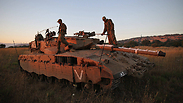
IDF building suppressive fire posts along the Syria border
The posts, similar to those already operative in Gaza, will coordinate between the different army units to offer quick response to any attack against Israel.
The suppressive fire posts, named by the IDF "Defensive Canopy," will be built in the 210th Territorial Division, that was recently established to secure the border with Syria.
Similar posts have already been built along the Gaza border to coordinate between different military elements in case of an attack against IDF troops. The coordination between the division, the Air Force and others elements, allows for a relatively quick response to suppress the attackers.
The attack stations are manned whenever necessary in accordance with situation and threat assessments.
Related stories:
- 13-year-old boy killed, 4 hurt in blast on Israel's Syria border
- Israel launches strikes on targets in Syria
- Two Syrian mortar shells land in Golan Heights
They will be built under the supervision of the artillery corps and their objective is to make the new division run more efficiently.
The new unit stationed at the posts will be commanded by an artillery officer.
"Defensive Canopy's objective is to shorten the range and time of response by clearly incriminating the enemy, and quickly synchronizing all of the forces and commanders in the field," a senior official in the artillery corps explained. "We will implement all of the things we learned in Gaza - in the Golan Heights. It's the same concept."
Two days ago, a 13-year-old boy was killed and three others were wounded by a Kornet missile, likely fired by Syrian army soldiers.
The IDF Northern Command is investigating why the Syrian army unit was not identified immediately after firing the anti-tank missile from an area considered relatively flat and easy to control.
The high state of alert along the Syrian border was expected to remain for at least 24 hours due to fear of a Syrian response to the IAF counterattack that claimed the lives of four Syrians.
Earlier, a senior defense official told Ynet that the military establishment was certain the missile that hit the Karakara family near the border fence on the Golan Heights was fired from a Syrian army position by soldiers in uniform and on duty.
Sources believed that there was more than one perpetrator and that the shooters were Syrian soldiers of the 90th brigade.
The IDF attacked its command posts and artillery positions even before the intelligence had been verified.
After the incident, the intelligence community had assumed the shooters were militia troops working on behalf of Hezbollah or with its assistance to fight on the side of Syrian President Bashar Assad.
The underlying assumption was that the Syrian military had vested interest in avoiding a direct confrontation with Israel, as it may weaken its capabilities in fighting the rebel forces. These basic assumptions are now being reexamined by the intelligence community.
One of the explanations provided for the incident was the possibility that it was the independent initiative of an officer or group of soldiers acting without orders from their commanders.
The anti-tank missile – an advanced Kornet model – blasted into the security barrier. The shrapnel and metal fragments from the fence hit the Israelis, as the missile is equipped with homing capabilities which allow accurate targeting from up to 10 km away.
The missile was fired from a short distance, a worrying fact for the military with dangerous implications. It is likely the IDF will change its operational directives and the precautionary measures taken to secure the barrier.
There was at least one case of a Syrian soldier firing a heavy machine gun of his own volition towards an IDF patrol keep driving on the Israeli side of the fence. The latest incident is similar, though significantly worse because of the type of weapon used in the attack.
A defense official explained that it is possible the incident occurred because the Syrian army has been facing a severe deterioration in unit discipline for more than a year.
Ron Ben Yishai contributed to this report.










